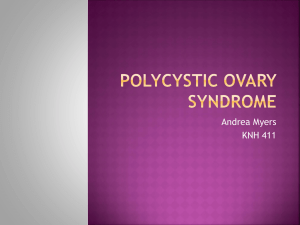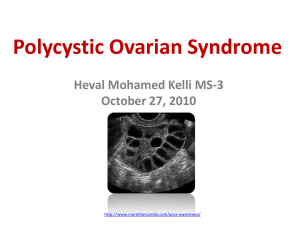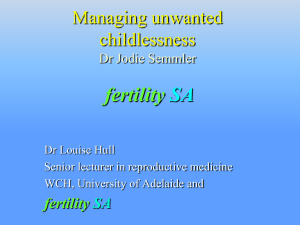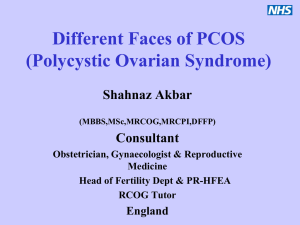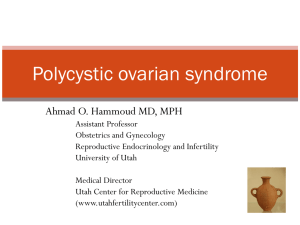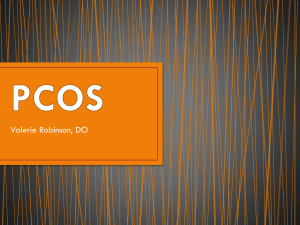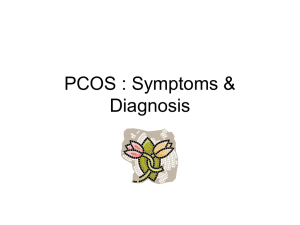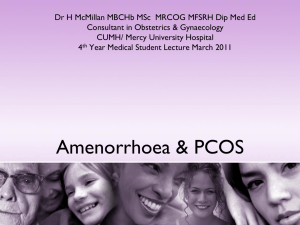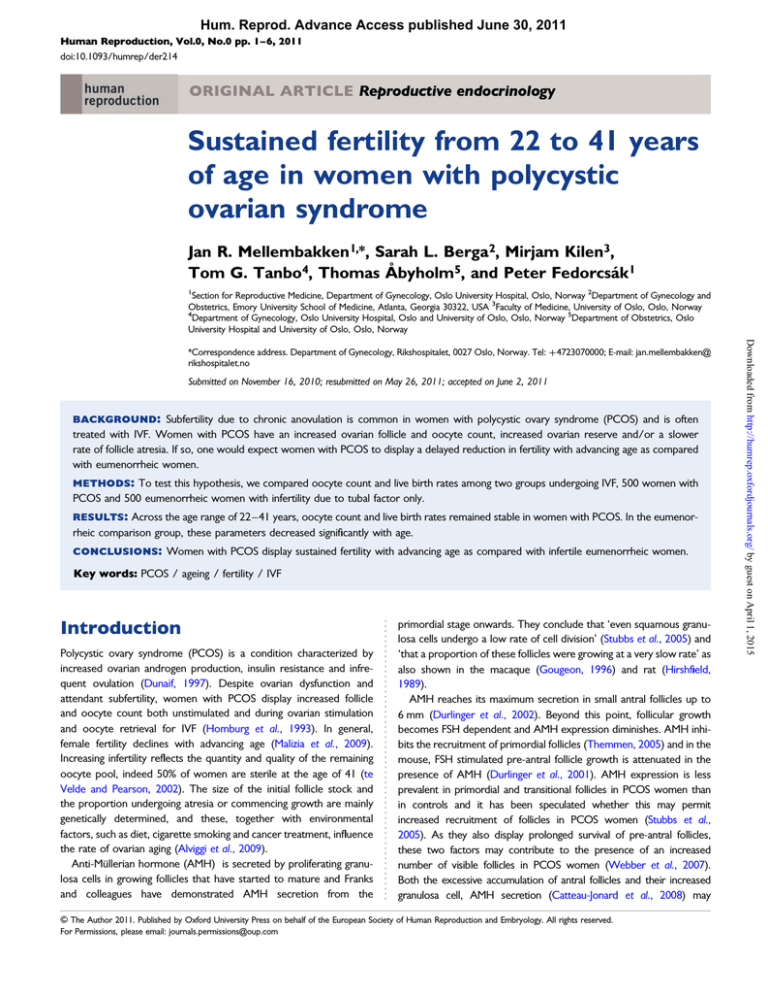
Hum. Reprod. Advance Access published June 30, 2011
Human Reproduction, Vol.0, No.0 pp. 1– 6, 2011
doi:10.1093/humrep/der214
ORIGINAL ARTICLE Reproductive endocrinology
Sustained fertility from 22 to 41 years
of age in women with polycystic
ovarian syndrome
Jan R. Mellembakken1,*, Sarah L. Berga 2, Mirjam Kilen 3,
˚ byholm 5, and Peter Fedorcsa´k 1
Tom G. Tanbo4, Thomas A
1
Section for Reproductive Medicine, Department of Gynecology, Oslo University Hospital, Oslo, Norway 2Department of Gynecology and
Obstetrics, Emory University School of Medicine, Atlanta, Georgia 30322, USA 3Faculty of Medicine, University of Oslo, Oslo, Norway
4
Department of Gynecology, Oslo University Hospital, Oslo and University of Oslo, Oslo, Norway 5Department of Obstetrics, Oslo
University Hospital and University of Oslo, Oslo, Norway
Submitted on November 16, 2010; resubmitted on May 26, 2011; accepted on June 2, 2011
background: Subfertility due to chronic anovulation is common in women with polycystic ovary syndrome (PCOS) and is often
treated with IVF. Women with PCOS have an increased ovarian follicle and oocyte count, increased ovarian reserve and/or a slower
rate of follicle atresia. If so, one would expect women with PCOS to display a delayed reduction in fertility with advancing age as compared
with eumenorrheic women.
methods: To test this hypothesis, we compared oocyte count and live birth rates among two groups undergoing IVF, 500 women with
PCOS and 500 eumenorrheic women with infertility due to tubal factor only.
results: Across the age range of 22 –41 years, oocyte count and live birth rates remained stable in women with PCOS. In the eumenorrheic comparison group, these parameters decreased significantly with age.
conclusions: Women with PCOS display sustained fertility with advancing age as compared with infertile eumenorrheic women.
Key words: PCOS / ageing / fertility / IVF
Introduction
Polycystic ovary syndrome (PCOS) is a condition characterized by
increased ovarian androgen production, insulin resistance and infrequent ovulation (Dunaif, 1997). Despite ovarian dysfunction and
attendant subfertility, women with PCOS display increased follicle
and oocyte count both unstimulated and during ovarian stimulation
and oocyte retrieval for IVF (Homburg et al., 1993). In general,
female fertility declines with advancing age (Malizia et al., 2009).
Increasing infertility reflects the quantity and quality of the remaining
oocyte pool, indeed 50% of women are sterile at the age of 41 (te
Velde and Pearson, 2002). The size of the initial follicle stock and
the proportion undergoing atresia or commencing growth are mainly
genetically determined, and these, together with environmental
factors, such as diet, cigarette smoking and cancer treatment, influence
the rate of ovarian aging (Alviggi et al., 2009).
Anti-Mu¨llerian hormone (AMH) is secreted by proliferating granulosa cells in growing follicles that have started to mature and Franks
and colleagues have demonstrated AMH secretion from the
primordial stage onwards. They conclude that ‘even squamous granulosa cells undergo a low rate of cell division’ (Stubbs et al., 2005) and
‘that a proportion of these follicles were growing at a very slow rate’ as
also shown in the macaque (Gougeon, 1996) and rat (Hirshfield,
1989).
AMH reaches its maximum secretion in small antral follicles up to
6 mm (Durlinger et al., 2002). Beyond this point, follicular growth
becomes FSH dependent and AMH expression diminishes. AMH inhibits the recruitment of primordial follicles (Themmen, 2005) and in the
mouse, FSH stimulated pre-antral follicle growth is attenuated in the
presence of AMH (Durlinger et al., 2001). AMH expression is less
prevalent in primordial and transitional follicles in PCOS women than
in controls and it has been speculated whether this may permit
increased recruitment of follicles in PCOS women (Stubbs et al.,
2005). As they also display prolonged survival of pre-antral follicles,
these two factors may contribute to the presence of an increased
number of visible follicles in PCOS women (Webber et al., 2007).
Both the excessive accumulation of antral follicles and their increased
granulosa cell, AMH secretion (Catteau-Jonard et al., 2008) may
& The Author 2011. Published by Oxford University Press on behalf of the European Society of Human Reproduction and Embryology. All rights reserved.
For Permissions, please email: journals.permissions@oup.com
Downloaded from http://humrep.oxfordjournals.org/ by guest on April 1, 2015
*Correspondence address. Department of Gynecology, Rikshospitalet, 0027 Oslo, Norway. Tel: +4723070000; E-mail: jan.mellembakken@
rikshospitalet.no
2
explain the increased circulating AMH level in PCOS women (Wang
et al., 2007). Age-related female infertility is mainly based on changes
in ovarian reserve, defined as the number and quality of the remaining
follicles in the ovaries at a given age. As AMH correlates well with
age and antral follicle count, it may constitute a sensitive marker for
ovarian aging. Moreover, the size of the monthly growing follicle pool
may reflect the unmeasureable number of primordial follicles in the
ovaries and thus indicate the ovarian reserve (Ledger, 2010).
Women with PCOS achieve similar pregnancy and live birth rates
per treatment cycle as normo-ovulatory women (Heijnen et al.,
2006). Since women with PCOS have both higher follicle counts
(Webber et al., 2007) and serum AMH concentrations (Tehrani
et al., 2010), we hypothesized that they could also have sustained fertility compared with controls. To test this assumption, we compared
oocyte number and live birth rates to chronological age in women with
PCOS and eumenorrheic controls undergoing IVF.
Selection of patients and study design
Patients in this cohort study were retrospectively identified in our clinical
database with detailed records on cycles of assisted reproduction treatments with IVF or ICSI. The complete cohort of women with PCOS
(n ¼ 708) was retrieved from the database. The diagnosis of PCOS was
based on the 2003 (The Rotterdam ESHRE/ASRM-Sponsored PCOS
Consensus Workshop Group, 2004), that is, the presence of at least
two of the following conditions: oligo/anovulation, hyperandrogenism
and polycystic ovaries. Attenuated 21-hydroxylase activity, Cushing syndrome, androgen-secreting tumors and hyperprolactinemia were excluded
by appropriate tests. The retrieved records were manually checked to
identify and exclude women with co-existing diseases, such as tubal
disease, male factor infertility and endometriosis. The final case cohort
contained 500 women with PCOS.
The control group consisted of eumenorrheic women who underwent
IVF or ICSI for tubal factor infertility only (n ¼ 856). We excluded women
with other co-existing conditions. These initial control cohorts differed
with respect to mean age (PCOS, 31.3 years; tubal factor, 33.4 years;
P , 0.001) and the shape of age distributions. To reduce bias in subsequent regression analyses and to obtain a similar age distribution in
the case and control groups, one woman from the tubal factor cohort
was matched with each woman in the PCOS cohort according to age
across the age range of 20–44 years. Matching was performed with the
nearest month of birth. Finally, each group consisted of 500 patients
after matching.
Ovarian stimulation and IVF
Ovarian stimulation and IVF were performed as previously described
(Bjercke et al., 2005). Briefly, pituitary down-regulation was achieved
with GnRH agonist (Suprecur, Sanofi-Aventis, Germany or Synarela,
Pfizer, Belgium) administered intranasally from the mid-luteal phase of
the preceding cycle in patients with regular menses. Patients with PCOS
who were oligomenorrheic were given a progestine to induce endometrial
sloughing. Recombinant FSH (Gonal-F, Merck Serono, Geneva, Switzerland or Puregon, Organon, Oss, The Netherlands) or human menopausal
gonadotrophin (Menopur, Ferring, Denmark) was given for ovarian stimulation. The standard starting dose was 75 IU daily in the PCOS group and
150 IU daily in the control group. The dose was adjusted after 5 – 9 days
according to the ovarian response. In some cases (n ¼ 7 in each group),
down-regulation with GnRH agonist was not performed and spontaneous
ovulation was prevented by administration of GnRH antagonist (Cetrotide,
Serono, Germany or Orgalutran, Organon, The Netherlands 0.25 mg
daily), beginning on the sixth day of stimulation with FSH or the day
when the largest follicle reached the diameter of 14 mm. Transvaginal
oocyte retrieval was performed 34 – 36 h after administration of 6500
or 10 000 IU human chorionic gonadotrophin (hCG, Ovitrelle, Serono
or Pregnyl, Organon). One or two embryos were transferred on Day 2
or Day 3 after follicle aspiration. Luteal phase support was provided as
intravaginal progesterone capsules (Progestan, Organon, 600 mg daily)
or gel (Crinone, Serono, 180 mg daily).
To avoid selection bias, only the first treatment was included in the
analysis. Pregnancy was defined by serum hCG concentration .20 IU/l
on Day 12 after embryo transfer. Ovarian hyperstimulation syndrome
was diagnosed by a combination of clinical symptoms (abdominal distension, nausea, excessive follicle development of .25 follicles per ovary,
or ascites) independent of hospitalization or outpatient management.
Body mass index (BMI, kg/m2) was assessed at the first visit.
Data analysis
Data are shown as mean and standard deviation or median and range.
Between-group comparisons were performed with chi-square test, t-test
or Mann– Whitney test as appropriate. P , 0.05 was considered statistically significant. To assess age-related ovarian capacity to mature follicles
in response to FSH stimulation, multiple regression analyses were performed in the case and control group using age, mean daily FSH dose
and BMI as independent variables (Fig. 1). In the PCOS group, a history
of ovarian surgery was also considered as a covariate. The analysis was
performed for the groups separately, and regression coefficients (slopes)
for age were compared between the groups with t-test.
Age-related changes in live birth rate were compared between the
groups by calculating age-specific regression coefficients with logistic
regression analysis. The age of the woman and the number of replaced
embryos were used as covariates in these analyses (Fig. 2).
The R program package (available at www.r-project.org) version 2.5.0
was used for statistical analysis and plotting the data.
Results
The age was similar in the two groups but women with PCOS had
higher BMI than women with tubal factor infertility and received
lower FSH dosage than controls, with a lower daily dose but a
more prolonged stimulation (Table I). The number of collected
oocytes was statistically comparable between the groups, whereas
the number of diploid fertilized oocytes was lower in the PCOS compared with the tubal factor infertility group. The number of cycles in
which no embryos were transferred was higher in the PCOS than in
the control group. No statistical differences were revealed among
the groups in terms of total pregnancy rate and pregnancy outcome
(Table I).
In the PCOS group, no significant association between age and
number of collected oocytes was observed [regression coefficient
(slope) +0.11, SE: 0.09, P ¼ 0.23]. In the tubal factor infertility
group, advanced age was associated with a reduced number of
retrieved oocytes (slope 20.12, SE: 0.06, P ¼ 0.05). The slopes for
regression lines (Fig. 1) differed significantly between the PCOS
group and tubal factor infertility (P ¼ 0.01).
In the PCOS group, a significant association between age and live
birth rate was not observed (coefficient: 20.001, P ¼ 0.96). In the
tubal factor infertility group, advanced age was associated with a
Downloaded from http://humrep.oxfordjournals.org/ by guest on April 1, 2015
Patients and Methods
Mellembakken et al.
3
Extended fertility in PCOS women
Figure 1 Number of collected oocytes during first treatment with IVF in women with PCOS or tubal factor infertility. Dotted lines indicate SE.
indicate SE.
significantly reduced probability of live birth (coefficient: 20.049, P ¼
0.03) (Fig. 2).
Discussion
The results indicate that women with PCOS maintain a stable oocyte
count and live birth rate across the age range of 22 –41 years during
IVF treatment, whereas normo-ovulatory women with tubal factor
infertility experience a significant decline with increasing age during
this period. Although the finding support the hypothesis that
women with PCOS have a sustained fertility compared with controls,
conclusions about the pace of ovarian aging cannot be drawn, since
the age range of 22–41 years does not cover subsequent events
during reproductive aging, such as the age at cessation of fertility or
menopause.
Sustained fertility in PCOS women is supported by many observations. First, women who had been infertile due to anovulation
experienced spontaneous pregnancies late in reproductive age
(Lunde et al., 2001; Vulpoi et al., 2007) and entered menopause
later than ovulatory women (Dahlgren et al., 1992). Second,
increased ovarian volume and follicle number was observed in
PCOS compared with controls across the age range of 20 years
to menopause (Asamarai et al., 2009), which is in accordance
with the observation that the serum AMH level is increased and
shows a slower rate of decline with aging in PCOS women
(Mulders et al., 2004; Tehrani et al., 2010). Finally, when treated
with in vitro maturation, which does not entail FSH stimulation,
women with PCOS have an increased number of oocytes collected
and higher live birth rate compared with controls (Child et al.,
2001). A sustained number of growing follicles, however, fails to
gain support by some other studies. Inhibin B is a marker of
ovarian antral follicle cohort in PCOS (Bili et al., 2001) and eumenorrheic women (Danforth et al., 1998). Bili et al. (2001) found
an age-related reduction in the number of antral follicles and a
decrease in inhibin B in 472 PCOS patients and Elting, in 27
women found an age-related reduction in inhibin B increment
during FSH-stimulated ovarian reserve testing (Elting et al., 2001).
However, Piltonen et al. (2004) found unchanged age-related
inhibin B levels in 42 women with PCOS. Inhibin B inhibits FSH
release, and a lower inhibin B level may contribute to a higher
FSH level and thus favor follicle growth with more regular and
more frequent ovulatory cycles in older women with PCOS.
Downloaded from http://humrep.oxfordjournals.org/ by guest on April 1, 2015
Figure 2 Predicted age-specific live birth rates for women with PCOS or tubal factor infertility undergoing first treatment with IVF. Dotted lines
4
Mellembakken et al.
Table I Clinical characteristics, ovarian stimulation and
treatment outcome among age-matched women with
PCOS and tubal factor infertility undergoing IVF.
PCOS
(n 5 500)
Tubal factor
infertility
(n 5 500)
P-value
........................................................................................
Age (years)
31.3 (3.6)
31.6 (3.2)
BMI (kg/m2)
26.5 (5.2)
23.5 (3.9)
Total FSH dose (IU) 1650 (525–9825) 1725 (525–2500)
,0.001
0.04
12 (6– 39)
11 (6–28)
,0.001
Number of
collected oocytes
9 (0– 39)
9 (0–33)
0.20
Number of diploid
fertilized oocytes
5 (0– 25)
6 (0–23)
,0.001
FSH treatment
(days)
,0.001
0 embryo
65 (13%)
1 embryo
102 (20%)
35 (7%)
79 (16%)
2 embryos
333 (67%)
386 (77%)
No. of pregnancies
169 (33.8%)
169 (33.8%)
0.99
No. of spontaneous
abortions
47 (9.4%)
36 (7.2%)
0.25
No. of ectopic
pregnancies
0
6
No. of stillbirths
1
0
No. of live births
121 (24.2%)
124 (24.8%)
0.82
Ovarian
hyperstimulation
syndrome
11 (2.2%)
3 (0.6%)
0.03
An alternative, though insufficiently corroborated, explanation for
sustained fertility in PCOS is a reduced pace of ovarian aging, possibly
involving pathways implicated in ovarian aging and aging in general.
In experimental models with worms (Tissenbaum and Ruvkun,
1998; Mukhopadhyay and Tissenbaum, 2007; Angelo and Van Gilst,
2009) and mice (Baba et al., 2005), conditions that slow metabolism
and confer metabolic efficiency also slow gamete aging, especially
when the metabolic efficiency is not the direct result of undernutrition
(Martin et al., 2007). Women with PCOS have been shown to be
metabolically efficient proportional to the extent of insulin resistance
(Robinson et al., 1992) which may be a manifestation of underlying
metabolic efficiency (Georgopoulos et al., 2009). However, our
study did not permit us to investigate whether this finding might be
associated with or causally related to metabolic efficiency or insulin
resistance.
We wish to highlight some limitations of our study. First, it is
uncertain whether oocyte count in IVF is a suitable marker for sustained fertility or ovarian aging in PCOS patients. Indeed, there is a
positive correlation between basal AMH levels and the number of
retrieved oocytes in women undergoing ovarian stimulation (La
Marca et al., 2010), but this is not the case for PCOS patients
(Wang et al., 2007). Moreover, the longer lifeline of follicles in
PCOS may make the correlation between the number of resting
Authors’ roles
J.R. Mellembakken had the idea to the study and wrote the main part
of the introduction and discussion; S.L. Berga had the overview and
contributed significantly to writing the introduction and discussion;
M.K. took the initial initiative of the study and wrote the initial abstract,
introduction and discussion; T.T. took part in the general discussion
and wrote some parts of the paper; T.A˚. took part in the general discussion and wrote a part of ‘patients and methods’; P.F. did the statistics and wrote the main part of ‘patients and methods’ and results as
well as parts of the discussion.
Downloaded from http://humrep.oxfordjournals.org/ by guest on April 1, 2015
Number of cycles
with transfer of
embryos
primordial follicles and growing follicles, i.e. AMH, less direct compared with controls. Second, the differences in endocrine and metabolic dysfunctions and thereby phenotype in PCOS women
constitute a wide continuum. Minor fertility derangements may
initially be successfully treated by simple treatment such as hormonal
ovulation induction with clomiphene citrate, ovarian surgery or
low-dose FSH stimulation therapies. The PCOS group in this study
required more complex therapy like IVF and the results of this
study may therefore constitute a subgroup of PCOS women.
Third, collection of an increased number of oocytes in older
women with PCOS may not imply a sustained oocyte quality.
It is uncertain how oocyte quality would be affected in aging polycystic ovaries. An increased density of follicles (Hughesdon, 1982;
Webber et al., 2003; Maciel et al., 2004), lower apoptotic rate of granulosa cells (Das et al., 2008) and decreased follicle loss through atresia
(Webber et al., 2007) may result in a larger resting follicle cohort,
which may be associated with an improved oocyte quality. Indeed,
in young women and also cattle, the antral follicle number and
AMH levels correlate with the number of morphologically healthy follicles and oocytes, response to ovulation induction, number of highquality transferable oocytes and blastocyst development (Scheffer
et al., 2003; Ireland et al., 2008). Furthermore, production of androstenedione and testosterone by theca cells may be inherently related to
the number of healthy growing follicles and low-circulation androgen
levels reflect a low number of follicles (Mossa et al., 2010) and a
poor ovarian response (Qin et al., 2011). As androgen levels are
higher in older PCOS women than in controls, they may experience
a better hormonal follicular function contributing to a relative better
oocyte quality. In addition, circulating FSH concentration is inversely
related to morphologically healthy follicles and oocytes (Ireland
et al., 2007). FSH is a positive regulator of aromatase, eastadiol receptors and estradiol production by granulosa cells (Silva and Price, 2000).
In normal women, FSH begins to increase at the age of 35 with a
marked increase beyond 40 years, whereas women with PCOS at
this age may achieve a normal menstrual cycle reflecting a sound hormonal constitution (Elting et al., 2000). Nonetheless, the ovarian
microenvironment may still undergo age-related deterioration increasing the proportion of oocytes with meiotic abnormalities. Assessment
of these defects, however, is challenging since routine morphological
scoring of oocytes fails to reflect age-related biological changes
(Stensen et al., 2010).
We conclude that our data indicate a better fertility with advanced
age in PCOS women compared with controls and that future research
may reveal the exact mechanisms for this phenomenon.
Extended fertility in PCOS women
Acknowledgement
Clinical data used in this article were assessed according to the
approval of the Data Protection Officer, Rikshospitalet Medical
Centre, Norway. As imposed by the Officer, this article must
hereby be marked ‘quality assurance’ solely to indicate this fact.
Funding
The authors have no financial conflict of interest. No external funding
was either sought or obtained for this study.
References
Dunaif A. Insulin resistance and the polycystic ovary syndrome: mechanism
and implications for pathogenesis. Endocr Rev 1997;18:774 – 800.
Durlinger AL, Gruijters MJ, Kramer P, Karels B, Kumar TR, Matzuk MM,
Rose UM, de Jong FH, Uilenbroek JT, Grootegoed JA et al.
Anti-Mullerian hormone attenuates the effects of FSH on
follicle development in the mouse ovary. Endocrinology 2001;
142:4891– 4899.
Durlinger AL, Visser JA, Themmen AP. Regulation of ovarian function: the
role of anti-Mullerian hormone. Reproduction 2002;124:601 – 609.
Elting MW, Korsen TJ, Rekers-Mombarg LT, Schoemaker J. Women with
polycystic ovary syndrome gain regular menstrual cycles when ageing.
Hum Reprod 2000;15:24 – 28.
Elting MW, Kwee J, Schats R, Rekers-Mombarg LT, Schoemaker J. The rise
of estradiol and inhibin B after acute stimulation with follicle-stimulating
hormone predict the follicle cohort size in women with polycystic ovary
syndrome, regularly menstruating women with polycystic ovaries, and
regularly menstruating women with normal ovaries. J Clin Endocrinol
Metab 2001;86:1589 – 1595.
Georgopoulos NA, Saltamavros AD, Vervita V, Karkoulias K, Adonakis G,
Decavalas G, Kourounis G, Markou KB, Kyriazopoulou V. Basal
metabolic rate is decreased in women with polycystic ovary syndrome
and biochemical hyperandrogenemia and is associated with insulin
resistance. Fertil Steril 2009;92:250 – 255.
Gougeon A. Regulation of ovarian follicular development in primates: facts
and hypotheses. Endocr Rev 1996;17:121– 155.
Heijnen EM, Eijkemans MJ, Hughes EG, Laven JS, Macklon NS, Fauser BC.
A meta-analysis of outcomes of conventional IVF in women with
polycystic ovary syndrome. Hum Reprod Update 2006;12:13 – 21.
Hirshfield AN. Granulosa cell proliferation in very small follicles of cycling
rats studied by long-term continuous tritiated-thymidine infusion. Biol
Reprod 1989;41:309– 316.
Homburg R, Berkowitz D, Levy T, Feldberg D, Ashkenazi J, Ben-Rafael Z.
In vitro fertilization and embryo transfer for the treatment of infertility
associated with polycystic ovary syndrome. Fertil Steril 1993;
60:858– 863.
Hughesdon PE. Morphology and morphogenesis of the Stein-Leventhal
ovary and of so-called ‘hyperthecosis’. Obstet Gynecol Surv 1982;
37:59– 77.
Ireland JJ, Ward F, Jimenez-Krassel F, Ireland JL, Smith GW, Lonergan P,
Evans AC. Follicle numbers are highly repeatable within individual
animals but are inversely correlated with FSH concentrations and the
proportion of good-quality embryos after ovarian stimulation in cattle.
Hum Reprod 2007;22:1687 – 1695.
Ireland JL, Scheetz D, Jimenez-Krassel F, Themmen AP, Ward F,
Lonergan P, Smith GW, Perez GI, Evans AC, Ireland JJ. Antral follicle
count reliably predicts number of morphologically healthy oocytes and
follicles in ovaries of young adult cattle. Biol Reprod 2008;79:1219– 1225.
La Marca A, Sighinolfi G, Radi D, Argento C, Baraldi E, Artenisio AC,
Stabile G, Volpe A. Anti-Mullerian hormone (AMH) as a predictive
marker in assisted reproductive technology (ART). Hum Reprod
Update 2010;16:113 – 130.
Ledger WL. Clinical utility of measurement of anti-mullerian hormone in
reproductive endocrinology. J Clin Endocrinol Metab 2010;
95:5144– 5154.
Lunde O, Djoseland O, Grottum P. Polycystic ovarian syndrome:
a follow-up study on fertility and menstrual pattern in 149 patients
15 – 25 years after ovarian wedge resection. Hum Reprod 2001;
16:1479– 1485.
Maciel GA, Baracat EC, Benda JA, Markham SM, Hensinger K, Chang RJ,
Erickson GF. Stockpiling of transitional and classic primary follicles in
ovaries of women with polycystic ovary syndrome. J Clin Endocrinol
Metab 2004;89:5321 – 5327.
Downloaded from http://humrep.oxfordjournals.org/ by guest on April 1, 2015
Revised 2003 consensus on diagnostic criteria and long-term health risks
related to polycystic ovary syndrome (PCOS). Hum Reprod 2004;
19:41–47.
Alviggi C, Humaidan P, Howles CM, Tredway D, Hillier SG. Biological
versus chronological ovarian age: implications for assisted reproductive
technology. Reprod Biol Endocrinol 2009;7:101.
Angelo G, Van Gilst MR. Starvation protects germline stem cells and
extends reproductive longevity in C. elegans. Science 2009;
326:954–958.
Asamarai S, Adams JM, Murphy MK, Post MD, Hayden DL, Hall JE,
Welt CK. Criteria for polycystic ovarian morphology in polycystic
ovary syndrome as a function of age. J Clin Endocrinol Metab 2009;
94:4961–4970.
Baba T, Shimizu T, Suzuki Y, Ogawara M, Isono K, Koseki H, Kurosawa H,
Shirasawa T. Estrogen, insulin, and dietary signals cooperatively regulate
longevity signals to enhance resistance to oxidative stress in mice. J Biol
Chem 2005;280:16417 –16426.
Bili H, Laven J, Imani B, Eijkemans MJ, Fauser BC. Age-related differences in
features associated with polycystic ovary syndrome in
normogonadotrophic oligo-amenorrhoeic infertile women of
reproductive years. Eur J Endocrinol 2001;145:749 –755.
Bjercke S, Fedorcsak P, Abyholm T, Storeng R, Ertzeid G, Oldereid N,
Omland A, Tanbo T. IVF/ICSI outcome and serum LH concentration
on day 1 of ovarian stimulation with recombinant FSH under pituitary
suppression. Hum Reprod 2005;20:2441–2447.
Catteau-Jonard S, Jamin SP, Leclerc A, Gonzales J, Dewailly D, di
Clemente N. Anti-Mullerian hormone, its receptor, FSH receptor,
and androgen receptor genes are overexpressed by granulosa cells
from stimulated follicles in women with polycystic ovary syndrome.
J Clin Endocrinol Metab 2008;93:4456 –4461.
Child TJ, Abdul-Jalil AK, Gulekli B, Tan SL. In vitro maturation and
fertilization of oocytes from unstimulated normal ovaries, polycystic
ovaries, and women with polycystic ovary syndrome. Fertil Steril 2001;
76:936–942.
Dahlgren E, Johansson S, Lindstedt G, Knutsson F, Oden A, Janson PO,
Mattson LA, Crona N, Lundberg PA. Women with polycystic ovary
syndrome wedge resected in 1956 to 1965: a long-term follow-up
focusing on natural history and circulating hormones. Fertil Steril 1992;
57:505–513.
Danforth DR, Arbogast LK, Mroueh J, Kim MH, Kennard EA, Seifer DB,
Friedman CI. Dimeric inhibin: a direct marker of ovarian aging. Fertil
Steril 1998;70:119 –123.
Das M, Djahanbakhch O, Hacihanefioglu B, Saridogan E, Ikram M, Ghali L,
Raveendran M, Storey A. Granulosa cell survival and proliferation are
altered in polycystic ovary syndrome. J Clin Endocrinol Metab 2008;
93:881–887.
5
6
Stensen MH, Tanbo T, Storeng R, A˚byholm T, Fedorcsak P. Routine
morphological scoring systems in assisted reproduction treatment fail
to reflect age-related impairment of oocyte and embryo quality.
Reprod Biomed Online 2010;21:118 – 125.
Stubbs SA, Hardy K, Da Silva-Buttkus P, Stark J, Webber LJ, Flanagan AM,
Themmen AP, Visser JA, Groome NP, Franks S. Anti-mullerian
hormone protein expression is reduced during the initial stages of
follicle development in human polycystic ovaries. J Clin Endocrinol
Metab 2005;90:5536 – 5543.
te Velde ER, Pearson PL. The variability of female reproductive ageing.
Hum Reprod Update 2002;8:141– 154.
Tehrani FR, Solaymani-Dodaran M, Hedayati M, Azizi F. Is polycystic ovary
syndrome an exception for reproductive aging? Hum Reprod 2010;
25:1775 – 1781.
Themmen AP. Anti-Mullerian hormone: its role in follicular growth
initiation and survival and as an ovarian reserve marker. J Natl Cancer
Inst Monogr 2005;34:18 – 21.
The Rotterdam ESHRE/ASRM-Sponsored PCOS Consensus Workshop
Group. Revised 2003 consensus on diagnostic and long-term health
risks related to polycystic ovary syndrome (PCOS). Hum Reprod 2004;
19:41 – 47.
Tissenbaum HA, Ruvkun G. An insulin-like signaling pathway affects both
longevity and reproduction in Caenorhabditis elegans. Genetics 1998;
148:703– 717.
Vulpoi C, Lecomte C, Guilloteau D, Lecomte P. Ageing and reproduction:
is polycystic ovary syndrome an exception? Ann Endocrinol (Paris) 2007;
68:45 – 50.
Wang JG, Nakhuda GS, Guarnaccia MM, Sauer MV, Lobo RA. Mullerian
inhibiting substance and disrupted folliculogenesis in polycystic ovary
syndrome. Am J Obstet Gynecol 2007;196:77.e1 – 77.e5.
Webber LJ, Stubbs S, Stark J, Trew GH, Margara R, Hardy K, Franks S.
Formation and early development of follicles in the polycystic ovary.
Lancet 2003;362:1017 – 1021.
Webber LJ, Stubbs SA, Stark J, Margara RA, Trew GH, Lavery SA,
Hardy K, Franks S. Prolonged survival in culture of preantral follicles
from polycystic ovaries. J Clin Endocrinol Metab 2007;92:1975 – 1978.
Downloaded from http://humrep.oxfordjournals.org/ by guest on April 1, 2015
Malizia BA, Hacker MR, Penzias AS. Cumulative live-birth rates after in
vitro fertilization. N Engl J Med 2009;360:236–243.
Martin B, Pearson M, Kebejian L, Golden E, Keselman A, Bender M,
Carlson O, Egan J, Ladenheim B, Cadet JL et al.
Sex-dependent metabolic, neuroendocrine, and cognitive responses
to dietary energy restriction and excess. Endocrinology 2007;
148:4318–4333.
Mossa F, Jimenez-Krassel F, Folger JK, Ireland JL, Smith GW, Lonergan P,
Evans AC, Ireland JJ. Evidence that high variation in antral follicle count
during follicular waves is linked to alterations in ovarian androgen
production in cattle. Reproduction 2010;140:713 –720.
Mukhopadhyay A, Tissenbaum HA. Reproduction and longevity: secrets
revealed by C. elegans. Trends Cell Biol 2007;17:65 –71.
Mulders AG, Laven JS, Eijkemans MJ, de Jong FH, Themmen AP,
Fauser BC. Changes in anti-Mullerian hormone serum concentrations
over time suggest delayed ovarian ageing in normogonadotrophic
anovulatory infertility. Hum Reprod 2004;19:2036–2042.
Piltonen T, Koivunen R, Perheentupa A, Morin-Papunen L, Ruokonen A,
Tapanainen JS. Ovarian age-related responsiveness to human
chorionic gonadotropin in women with polycystic ovary syndrome.
J Clin Endocrinol Metab 2004;89:3769 –3775.
Qin Y, Zhao Z, Sun M, Geng L, Che L, Chen ZJ. Association of basal
serum testosterone levels with ovarian response and in vitro
fertilization outcome. Reprod Biol Endocrinol 2011;9:9.
Robinson S, Chan SP, Spacey S, Anyaoku V, Johnston DG, Franks S.
Postprandial thermogenesis is reduced in polycystic ovary syndrome
and is associated with increased insulin resistance. Clin Endocrinol
1992;36:535 –536.
Scheffer GJ, Broekmans FJ, Looman CW, Blankenstein M, Fauser BC,
teJong FH, teVelde ER. The number of antral follicles in normal
women with proven fertility is the best reflection of reproductive age.
Hum Reprod 2003;18:700 –706.
Silva JM, Price CA. Effect of follicle-stimulating hormone on steroid
secretion and messenger ribonucleic acids encoding cytochromes
P450 aromatase and cholesterol side-chain cleavage in bovine
granulosa cells in vitro. Biol Reprod 2000;62:186–191.
Mellembakken et al.


